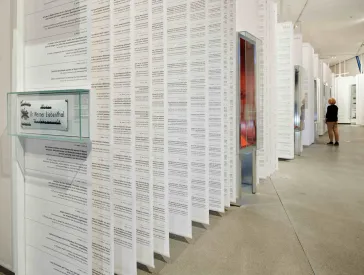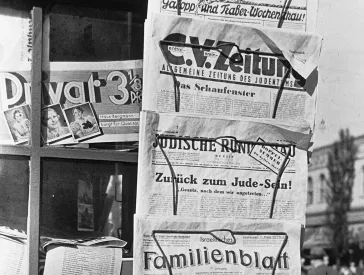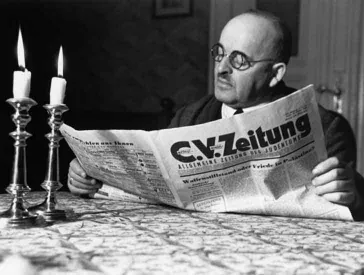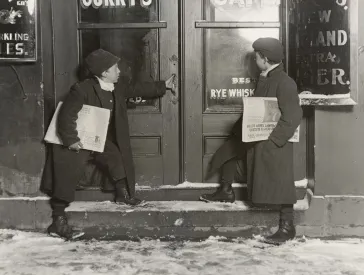Special Exhibition "Forced Labor. The Germans, the Forced Laborers, and the War"
Press Invitation to the Press Conference and the Exhibition Opening
Press Release, Wed 8 Sep 2010
Federal President Christian Wulff Speaks on 27 September at the Beginning of the Exhibition’s International Tour
Over 20 million men, women, and children were taken to Germany and the occupied territories from all over Europe as "foreign workers," prisoners of war, and concentration camp inmates to perform forced labor. By 1942, forced laborers were part of daily life in Nazi Germany. The deported workers from all over Europe and Eastern Europe in particular were exploited in armament factories, on building sites and farms, as craftsmen, in public institutions and private households. Be it as a soldier of the occupying army in Poland or as a farmer in Thuringia, all Germans encountered forced laborers and many profited from them. Forced labor was no secret but a largely public crime.
The exhibition "Forced Labor. The Germans, the Forced Laborers, and the War" provides the first comprehensive presentation of the history of forced labor and its ramifications after 1945. The exhibition was curated by the Buchenwald and Mittelbau-Dora Memorials Foundation and initiated and sponsored by the "Remembrance, Responsibility and Future" Foundation. Federal President Christian Wulff has assumed patronage for the exhibition. The exhibition’s first venue on its international tour is the Jewish Museum Berlin, other venues are planned in European capitals and in North America.
We cordially invite you to attend the press conference and the opening of this exhibition on Monday 27 September 2010.
Press Conference Speakers
Cilly Kugelmann, program director, Jewish Museum Berlin
Volkhard Knigge, director, Buchenwald and Mittelbau-Dora Memorials Foundation
Jens-Christian Wagner, exhibition curator and director of the Mittelbau-Dora Memorial Site
Günter Saathoff, board member, "Remembrance, Responsibility and Future" Foundation
Rikola-Gunnar Lüttgenau, exhibition curator and deputy director of the Buchenwald and Mittelbau-Dora Memorials Foundation will also be available for interviewing.
| Press Conference | 27 September 2010, 11 am, Exhibition preview from 10 am |
|---|---|
| Where | Old Building, first level, Education Room |
Evening Opening Program
- Words of Welcome:
W. Michael Blumenthal, director, Jewish Museum Berlin - Opening Speech:
Federal President Christian Wulff, patron of the exhibition - Remembering and Understanding:
Günter Saathoff, board member, "Remembrance, Responsibility and Future" Foundation - The Exhibition:
Volkhard Knigge, director, Buchenwald and Mittelbau-Dora Memorials Foundation - Memories of a Former Forced Laborer:
Marian Turski, historian, journalist, and survivor of the Auschwitz and Buchenwald concentration camps
| Exhibition Opening | 27 September 2010, 7 pm |
|---|---|
| Where | Glass Courtyard, ground level |
| Admission | free |
There will be a photo opportunity with the Federal President in the exhibition for press photographers and TV teams. This will be for accredited journalists only. The accreditation deadline is 22 September. Please find the application form at the end of this press invitation. Thank you.
| Photo Opportunity | 27 September 2010, 6 pm |
|---|---|
| Where | Old Building, ground level, Meeting Point at the press desk |
- Contact
-
Press office
T +49 (0)30 259 93 419
presse@jmberlin.de
- Address
Jewish Museum Berlin Foundation
Lindenstraße 9–14
10969 Berlin
The Exhibition "The Germans, the Forced Laborers, and the War"
Forced labor was without precedent in European history. No other Nazi crime involved so many people – as victims, perpetrators, or onlookers. The exhibition provides the first comprehensive presentation of the history of this ubiquitous Nazi crime and its ramifications after 1945. It shows how forced labor was part of the Nazi regime’s racist social order from the outset: The propagated "Volksgemeinschaft" (people’s community) and forced labor for the excluded belonged together. The German "Herrenmenschen" (superior race) ruthlessly exploited those they considered "Untermenschen" (subhumans). The ordinariness and the broad societal participation of forced labor reflect the racist core of Nazism.
The exhibition pays special attention to the relationships between Germans and forced laborers. Every German had to decide whether to treat forced laborers with a residual trace of humanity or with the supposedly required racist frostiness and implacability of a member of an allegedly superior race. How Germans made use of the scope this framework reveals something not only about the individuals but also about the allure and shaping power of Nazi ideology and practice. Through this perspective, the exhibition goes beyond a presentation of forced labor in the narrow sense to illustrate the extent to which Nazi values had infiltrated German society. Forced labor cannot be passed off as a mere crime of the regime but should rather be considered a crime of society.
Over 60 representative case histories form the core of the exhibition. As is true of the majority of documents on show, they resulted from meticulous investigations in Europe, the USA, and Israel. Moreover the exhibition team viewed hundreds of interviews with former forced laborers that have been carried out in recent years. In terms of content, these case histories range from the degrading work of the politically persecuted in Chemnitz through the murderous slave labor performed by Jews in occupied Poland to daily life as a forced laborer on a farm in Lower Austria.
Among the surprises of the extensive international archival research was discovering unexpectedly broad photographic coverage of significant events. The photos relating to the case histories represent the second pillar of the exhibition. Whole series of photos were traced back to their creator and the scene and people depicted. This presentation, based on well-founded sources, allows quasi dramatic insight into aspects of forced labor. Cinematically arranged photo or photo-detail enlargements form the introduction to the continued inquiry into the history of forced labor.
The exhibition is divided into four sections. The first covers the years from 1933 to 1939 and unveils in particular how the racist ideology of Nazi forced labor struck roots. What was propagated up to the beginning of WWII, partly laid down in laws and widely implemented by society in practice, formed the basis for the subsequent radicalization of forced labor in occupied Europe culminating in extermination through labor. This escalation and radicalization is the focus of the second section of the exhibition. The third part covers forced labor as a mass phenomenon in the Third Reich from 1941/42, ending with the massacre of forced laborers at the end of the war. The fourth section explores the period from the time of liberation in 1945 to society’s analysis and recognition of forced labor as a crime today. Former forced laborers have the last word.
An exhibition by the Buchenwald and Mittelbau-Dora Memorials Foundation at the Jewish Museum Berlin, initiated and sponsored by the Foundation "Remembrance, Responsibility and Future," and designed by gewerk design. Patron: Federal President Christian Wulff.
With the kind support of the Wall AG.
| Exhibition Dates | 28 September 2010 to 30 January 2011 |
|---|---|
| Where | Old Building, first level |
| Admission | 4 €, reduced rate 2 euros |
Further information on the exhibition can be found at: www.ausstellung-zwangsarbeit.org
There will be a companion volume to the exhibition in German and English:
"Forced Labor. The Germans, the Forced Laborers, and the War," edited by Volkhard Knigge, Rikola-Gunnar Lüttgenau, and Jens-Christian Wagner on behalf of the Buchenwald and Mittelbau-Dora Memorials Foundation, Weimar 2010.
Approximately 260 pages with around 170 pages presenting the exhibition and around 60 pages of academic contributions by renowned authors including Dieter Pohl, Dietmar Süß, and Constantin Goschler. 200 illustrations, paperback with thread stitching.
Price: 19.80 euros
ISBN German edition: 3-935598-17-3
ISBN English edition: 3-935598-18-1
For review copies please contact:
Mr Philipp Neumann
Buchenwald and Mittelbau-Dora Memorials Foundation
Press and Public Relations
Tel.: +49(0)3643-430156
Fax: +49(0)3643-430100
E-mail: pneumann@buchenwald.de



